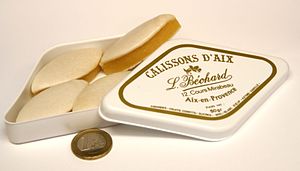 | |
| Alternative names | canisson, canissoun |
|---|---|
| Type | Confectionery |
| Place of origin | France |
| Serving temperature | cold |
| Main ingredients | candied fruit (especially melons and oranges), almond meal or flour, fondant |
Calissons are a traditional French candy consisting of a smooth, pale yellow, homogeneous paste of candied fruit (especially melons and oranges) and ground almonds topped with a thin layer of royal icing. They have a texture similar to that of marzipan, but with a fruitier, distinctly melon-like flavour. They are often almond-shaped and are typically about five centimeters (two inches) in length.
Calissons are traditionally associated with the town of Aix-en-Provence, France, and most of the world's supply is still made in the Provence region.
History
The calisson is believed to have its origins in south of France. Its most probable etymology, established by the sociolinguist specializing in Provençal Philippe Blanchet in 1998, is that the Provençal word calissoun is formed from “chalice” and from the diminutive “-oun”, meaning “small chalice”. Small in size and small in sacred value. The word "chalice", in fact, in Provençal as in French (we have the form "calitz" from the ancient langue d'oc), first designated the sacred cup of the Eucharist, and by extension communion itself. Now communion is wine and the host, distributed in a cup. And the calisson is, ritually, a kind of host.
A popular legend traces the introduction of calissons to Provence around the mid-15th century at the second wedding of King René of Anjou. Others suggest that it was not introduced in its modern form until the 16th century, as this was when almonds became an established crop in Aix-en-Provence.
Protected Geographical Indication (PGI)
The calisson status has been protected in France since 1991 which means that local manufacturers need to follow strict methods to make them and that only applies in France. During 14 years, the French Union of Calisson makers were not able to get the international rights over the calisson as they could not agree on the exact ingredients of the recipe. To prevent foreign companies from using the Calisson d'Aix name, the union applied for the Protected Geographical Indication (PGI) in 2015 but it was already too late. In 2016, the French Union makers started a long legal battle with a Chinese company who had already trademarked the candy in China under the "Kalisong" designation. In 2017 the French union finally won and blocked the Chinese trademark registration.
See also
References
- Hopkins, Kate (2012). Sweet Tooth: The Bittersweet History of Candy (1st ed.). New York: St. Martin's Press. p. 112. ISBN 9780312668105.
- Blanchet, Philippe; Turc, Jean-Michel; Venture, Rémi (7 April 2016). La Provence pour les Nuls poche (in French). edi8. ISBN 978-2-7540-8952-4.
- Langer, Patrick (1999). Calissons d'Aix, Nougats de Provence (in French). Equinox. ISBN 2841351580.
- "Calissons". Aix en Provence Tourism Office. Archived from the original on 20 September 2010. Retrieved 25 January 2011.
- "France battles China over sweets trademark". BBC. 16 November 2016. Retrieved 31 January 2019.
- "Sweet Victory: French Candymakers Win China Legal War". VOA. Agence France-Presse. 13 December 2017. Retrieved 31 January 2019.
External links
| Nut and seed confections | |||||||||
|---|---|---|---|---|---|---|---|---|---|
| Whole or crushed |
| ||||||||
| Ground | |||||||||
| Puréed | |||||||||
| Filling, topping or base |
| ||||||||
This confectionery-related article is a stub. You can help Misplaced Pages by expanding it. |